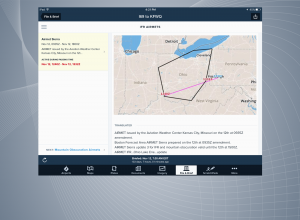

Sometimes it seems like pilots specialize in old wives’ tales. We still hear the one about how the iPad isn’t a legal replacement for paper charts occasionally (here’s why that’s 100% wrong). But here’s another one that just won’t die: “Well, that fancy iPad app doesn’t count as an official weather briefing. You have to call Flight Service or the FAA will nail you.”
It makes a great story, and it plays to pilots’ innate paranoia, but it’s completely false. It’s time to bury this old wives’ tale once and for all.
First of all, there is no such thing as an “official weather briefing.” It’s not defined anywhere in the Federal Aviation Regulations (FARs), the Aeronautical Information Manual (AIM) or the Pilot/Controller Glossary. The only regulation pertaining to pre-flight briefings is FAR 91.103:
Each pilot in command shall, before beginning a flight, become familiar with all available information concerning that flight. This information must include—
(a) For a flight under IFR or a flight not in the vicinity of an airport, weather reports and forecasts, fuel requirements, alternatives available if the planned flight cannot be completed, and any known traffic delays of which the pilot in command has been advised by ATC;
(b) For any flight, runway lengths at airports of intended use, and the following takeoff and landing distance information:
(1) For civil aircraft for which an approved Airplane or Rotorcraft Flight Manual containing takeoff and landing distance data is required, the takeoff and landing distance data contained therein; and
(2) For civil aircraft other than those specified in paragraph (b)(1) of this section, other reliable information appropriate to the aircraft, relating to aircraft performance under expected values of airport elevation and runway slope, aircraft gross weight, and wind and temperature.
This is all good information to know, but it says nothing about where the briefing must come from. And any decent aviation app will provide all of this information.

AIM 5-1-1 simply says, “Every pilot is urged to receive a preflight briefing and to file a flight plan. This briefing should consist of the latest or most current weather, airport, and en route NAVAID information.” It states that Flight Service is still the main way many pilots access this information, but it hardly requires it.
In fact, the FAA has a helpful publication that is specifically designed to help pilots conduct a good weather self-briefing. They know that more and more pilots are getting weather information from sources outside of Flight Service, so they’re offering to help pilots do a better job of it. Would they encourage that if such briefings weren’t “legal?”
But even if there’s not an FAR that requires pilots to get a Flight Service briefing, what about the concern that the FAA will throw the catch-all “careless and reckless” charge at you in the event of an accident or incident? Shouldn’t you get a briefing on file somewhere to prove that you did some pre-flight planning?
It doesn’t hurt, but your app qualifies. We checked with ForeFlight CEO Tyson Weihs, who confirmed that the company does indeed log all briefings. So when you use the File & Brief tool before your next flight, that information is saved at ForeFlight. Furthermore, says Weihs, “We routinely help the NTSB in post accident analysis.”
Beyond that, ForeFlight goes to some length to meet high standards with their servers and weather products. At one time, the FAA had a formal program for approving pre-flight weather providers, called Qualified Internet Communication Provider (QICP). Weihs says, “Although the QICP program is now disbanded, we still maintain these standards, including data recording.”
If you like to call Flight Service, by all means keep calling them. But there’s no reason to do it just to create a paper trail. You’re not cheating by using your iPad.
Source: Ipad appsQuit worrying: there is no such thing as an “official weather briefing”